Review by Darren Griffin
Introduction
RoyalTek are a long established and well respected manufacturer of GPS devices, we here at PocketGPSWorld have been reviewing devices from this Taiwanese based company for many years, our very first review of a RoyalTek GPS receiver, the RGM-2000 was way back in 2003.
RoyalTek have had a number of very popular receivers, the RGM-2000 was very successful and they also brought us one of the first Datalogger GPS devices, the RBT-3000 which also proved to be a big sales hit.
UK RoyalTek retailer Jactron have provided us with a selection of five of their current product range and so we have taken this opportunity to produce a brief overview. Although not a full review of every device we have covered those that we think will be the most popular and relevant in detail.
|
|
|
 RBT-2200 Bluetooth GPS RBT-2200 Bluetooth GPS
£40.84 +VAT
The RBT-2200 case bears a close resemblance to the RBT-1000 we reviewed in 2005. No bad thing as the form factor is near perfect for an every day Bluetooth GPS receiver. In the box you get the receiver, removable battery (a 650mAh Li-ion type), 12v charge cable and driver CD (full sized CD, see later!). A mains adapter is available as an optional extra.
Externally there is a simple hardware ON/OFF switch, a rubber flap covering the power socket and three status LED's for power, Bluetooth and GPS.
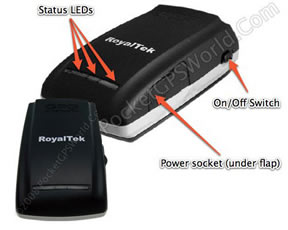
The GPS receiver is the ubiquitous SiRFStarIII and in-use it performed as we would expect with very fast acquisition and good sensitivity. BT receivers with physical ON/OFF switches are a rarity these days and so this makes a welcome re-appearance. Such a feature allows the device to be remotely located in a car and if connected to external power it will switch ON/OFF with the ignition.
Specification:
| General |
|
| Dimensions |
72mm x 41mm x 24mm |
| Weight |
62g (without battery) |
| Specification |
|
| GPS |
SiRF StarIII LP |
| Channels |
20 parallel |
| Fix time |
Reacquisition: less than 1s |
| |
Hot start: less than 1s |
| |
Warm start: less than 35s |
| |
Cold start: less than 35s |
| Interface Protocol |
NMEA 0183 ver. 3.0,GGA, GSA, RMC and GSV every 1s |
| DGPS |
WAAS, EGNOS |
| Device Interface |
|
| External Connector |
Power jack |
| Buttons |
Power Switch |
| LED Indicators |
Power, Bluetooth and GPS Status |
| Power Source |
|
| Rechargeable |
680mAh Li-Ion |
| Power Consumption |
75mA(Typical) at 5.0V |
| Battery Life |
6hrs |
GPS receivers such as these are the workhorses, I have a dozen similar devices from different manufactures and performance wise there is little to differentiate them. The RBT-2000 scores with its hardware ON/OFf switch and form factor, not too big nor too small. being black it's discrete, has a lanyard attachment should you need it and works.
 RGM-3800 Bluetooth GPS/Datalogger RGM-3800 Bluetooth GPS/Datalogger
£42.55 +VAT
The 3800 is a small matchbox sized datalogger. Great for logging any journey, holidays, walks, cycle rides etc or even for adding location data to photographs.
Eschewing the normal black/grey square box the 3800 sports an attractive white case with rounded ends and comes complete with both lanyard and key ring attachments.
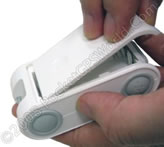
Power is supplied by two AAA batteries and on the outside are mini-USB, Power ON/OFF and memory reset button along with a single status LED.
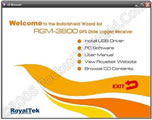 The 3800 is Windows Only so the first issue encountered was installing the driver and data download software. Royaltek supply the software on a mini CD, my only Windows PC (I'm a predominantly an Apple Mac user) is my Apple MacBook that dual boots OS X and Windows and has a slot loading drive so cannot read the mini CD fomat and so I was unable to access the files supplied. A quick visit to Royaltek's web site however and I was armed with the USB driver and download software. The 3800 is Windows Only so the first issue encountered was installing the driver and data download software. Royaltek supply the software on a mini CD, my only Windows PC (I'm a predominantly an Apple Mac user) is my Apple MacBook that dual boots OS X and Windows and has a slot loading drive so cannot read the mini CD fomat and so I was unable to access the files supplied. A quick visit to Royaltek's web site however and I was armed with the USB driver and download software.
Installation is straight-forward. The USB driver installed quickly and on completion it usefully tells you what COM Port it has installed the 3800 on. Make a note as you'll need to know this later!
Installing the datalogger download application is similarly straight forward and trouble free. Once installed and with the 3800 connected via USB (USB cable supplied), all that remains is to fire up the datalogger and configure the COM Port. Enter the COM Port you noted above:
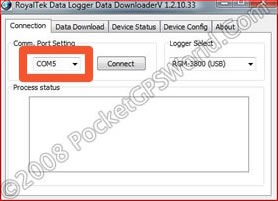 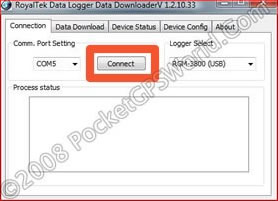
COM Port Configuration and Connection
Once done click Connect and you're done. Selecting the Data Download tab will show you the available log files on the 3800:
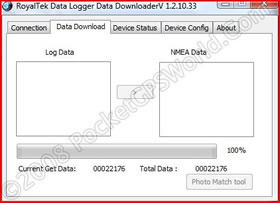
The Device Status tab (below left) shows you the status of the device! here you can view memory status, configure the logging for position, position and speed or position, speed and altitude. You can also configure the logging interval and whether the memory is overwritten when full or stops logging.
The config tab allows you to set the path where log files are saved.
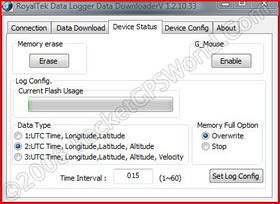 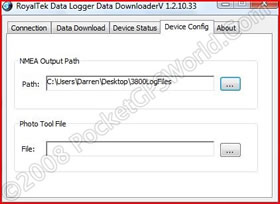
Externally the simple design is followed through with just a Power ON/OFF button (again a physical Push to switch ON, push to switch OFF type)
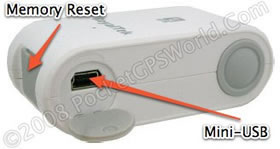 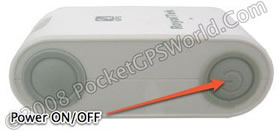
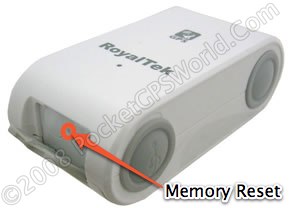
External port and switch locations
The logger was used extensively over a number of weeks. Battery life was excellent and the download software is simple to use.
To output the extracted log files I use an old favourite, GPSVisualizer . The log files are in NMEA format and GPSVisualizer will happily accept these. Here is an example from a recent trip into London:
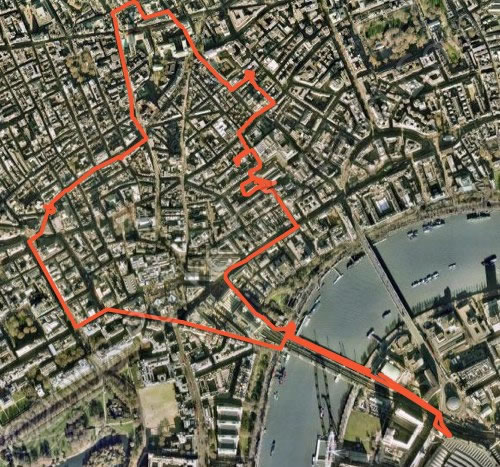
Specification:
| General |
|
| Dimensions |
70mm x 36.6mm x 24mm |
| Weight |
50g (without battery) |
| Specification |
|
| GPS |
SiRF 3/LP |
| Channels |
20 parallel |
| Fix time |
Reacquisition: less than 1s |
| |
Hot start: less than 1s |
| |
Warm start: less than 35s |
| |
Cold start: less than 42s |
| Interface Protocol |
NMEA 0183 ver. 3.0,GGA, GSA, RMC and GSV every 1s |
| DGPS |
WAAS, EGNOS |
| Log |
|
| Memory |
64Mb Flash |
| Log data |
Date, UTC Time, Longitude, Latitude, Altitude, Velocity |
| Log Interval |
5secs - 60secs, user configurable (Default 15secs) |
| Device Interface |
|
| External Connector |
Mini-USB |
| Buttons |
Power Switch and Memory Re-flash |
| LED Indicators |
Power, Memory and GPS Status |
| Power Source |
|
| Replaceable |
Alkaline batteries 1.5v AA x 2 |
| Power Consumption |
70mA(Typical) at 3.0V |
With 64Mb of on-board Flash memory you can expect approximately two days of logging at 15sec intervals before the memory is filled.
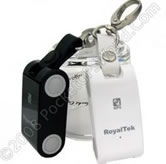
Portable and small
Because this device is so small it can be comfortably carried and does not look 'odd' hung around your neck. It will be accompanying me on my summer holidays so I can keep a record of our travels. The only downside is its lack of Apple Mac support. It would be much friendlier if the internal memory mounted as a disk drive in the same way as a USB memory key, then the log files could be easily extracted from any PC.
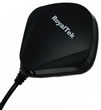 RGM-3600 USB Wired GPS RGM-3600 USB Wired GPS
£32.01 +VAT
Wired GPS receivers were once a very popular solution but the availability of dedicated PND's or PocketPC's with Bluetooth have made them much less so. However there are still applications where they work well.
The RGM-3600 has a magnetic base so that it can be attached to your car roof and a 1.5m long lead terminating in a USB plug on this model although it can also be purchased in RS232 and DIN versions.
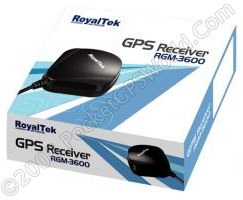
Specification:
| General |
|
| Dimensions |
48.4mm x 48.4mm x 15mm |
| Weight |
30 grams |
| Specification |
|
| GPS |
SiRF StarIII |
| Channels |
20 parallel |
| Fix time |
Reacquisition: less than 1s |
| |
Hot start: less than 1s |
| |
Warm start: less than 35s |
| |
Cold start: less than 42s |
| Interface Protocol |
NMEA 0183 ver. 3.0,GGA, GGL, GSA, RMC and VTG every 5s |
| DGPS |
WAAS, EGNOS |
| Device Interface |
|
| External Connector |
USB |
| Power Source |
|
| USB |
5v via USB |
Unlike models using earlier generation chip sets there is no need to have this receiver mounted externally any more. In many scenarios it will work fine on the dashboard etc as it uses SiRFStarIII.
 RTG-2000 Bluetooth GPS with TMC RTG-2000 Bluetooth GPS with TMC
£51.05 +VAT
This is a Bluetooth GPS receiver that also contains a TMC receiver/decoder. There are a few applications available currently that support such a solution, Destinator being one of them.
This allows a compatible PocketPC or Smartphone running compatible software to take advantage of TMC Traffic Data. To receive the RDS-FM TMC signal RoyalTek provide a 1.5m long wire antenna that connects to the body of the RTG-2000 via a headphone style jack. The antenna has two suction cups attached to allow you to run it around the edge of your windscreen.
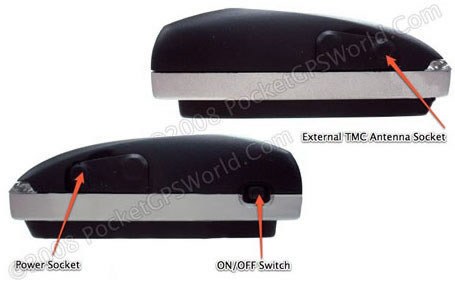
The case itself is very similar in shape and design to the RBT-2200 but differs in being slightly taller (3mm to be precise!) and has a non-removable battery.
I did not have a compatible application with which to test the TMC functionality directly but the utility and documentation CD provided does include test utility for PocketPC and PC (although it states XP it worked fine under Vista on my MacBook) that allows you to test both standard GPS functionality AND TMC reception.
As this device is intended for PocketPC's, Smartphones and Laptop's running compatible TMC aware navigation software I can forgive this the lack of Apple Mac support (but only just!).
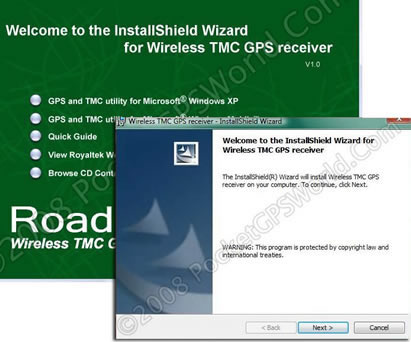
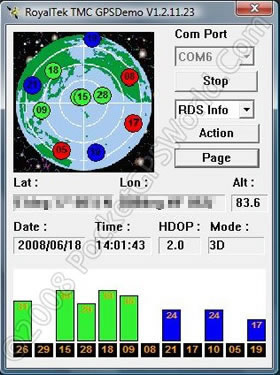 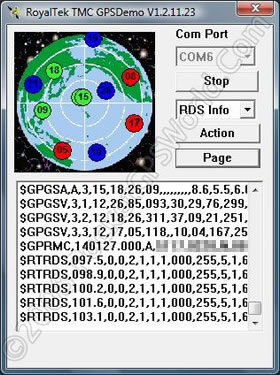
GPS Signal Status and NMEA Sentences
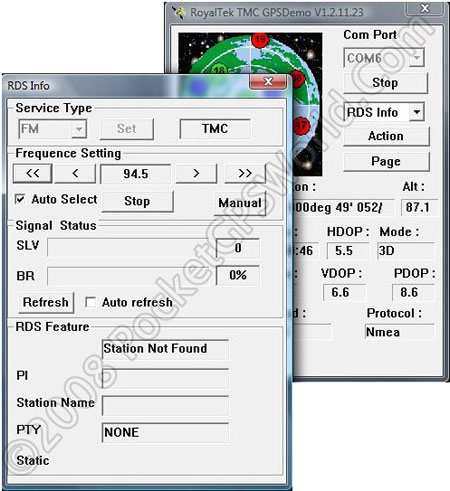
RDS TMC Info Test Page
Specification:
| General |
|
| Dimensions |
72mm x 42mm x 27mm |
| Weight |
62g (without battery) |
| Specification |
|
| GPS |
SiRF StarIII |
| Channels |
20 parallel |
| Fix time |
Reacquisition: less than 1s |
| |
Hot start: less than 1s |
| |
Warm start: less than 35s |
| |
Cold start: less than 42s |
| Interface Protocol |
NMEA 0183 ver. 3.0,GGA, GSA, RMC and GSV every 5s and RoyalTek TMC protocol |
| DGPS |
WAAS, EGNOS |
| Device Interface |
|
| External Connector |
Power jack and external TMC antenna |
| Buttons |
Power Switch |
| LED Indicators |
Power (and TMC), Bluetooth and GPS Status |
| Power Source |
|
| Rechargeable |
650mAh Li-Ion |
| Power Consumption |
75mA(Typical) at 5.0V |
If you have a compatible navigation application that supports this type of RDS TMC solution then it offers a simple and practical answer to getting TMC. As always though, the vagaries of TMC reception here in the UK make it very much less use than it might otherwise be. I live in a TMC dead zone and am unable to pick up a TMC signal on any device I have tested to date and this was no different.
 MBT-1000 Bluetooth GPS MBT-1000 Bluetooth GPS
It's very difficult to come up with new ideas for the design of GSP receivers, we've seen them in cigarette lighter plugs, necklaces, key rings and now RoyalTek have invented the 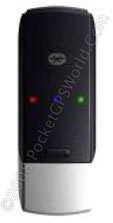 the wearable GPS! the wearable GPS!
The MBT-1000 has a large clip on the rear allowing it to be hung off a shirt pocket, shoulder strap etc and is about the size of a lipstick (I don't have any of my own so compared against Mrs G's!).
It differs from the others here in using the MediaTek chip-set. Mediatek or MTK as they are otherwise known were the new kids on the block a year or so ago but have become very much main stream now. They offer a receiver design that stands up well against the more expensive SiRFStarIII design and is similarly economic with its use of power. Close comparison shows the MTK option to be very slightly slower in signal acquisition and sensitivity but this is only apparent using measuring equipment, in real world use few users would notice any difference.
Other key features are a single front mounted soft ON/OFF power switch, three status LED's and a micro-USB connector mounted on the bottom for charging (micro-USB cable supplied). The rear mounted clip is removable and their is a lanyard slot on the top should you wish to carry it in that way instead.
Weighing in at an incredible 38g with battery this is a featherweight unit but still capable of running for a shade under 10hrs, very impressive for such a tiny unit. A sister MBT-1100 unit is also available with data logging functionality.
Specification:
| General |
|
| Dimensions |
69.5mm x 23mm x 20mm |
| Weight |
38 grams (with battery) |
| Specification |
|
| GPS |
MTK |
| Channels |
32 parallel |
| Fix time |
Reacquisition: less than 1s |
| |
Hot start: less than 2s |
| |
Warm start: less than 40s |
| |
Cold start: less than 40s |
| Interface Protocol |
NMEA 0183 ver. 3.0,GGA, GSA, RMC and GSV |
| DGPS |
WAAS, EGNOS |
| Device Interface |
|
| External Connector |
Micro-USB 8-pin |
| Buttons |
Power Switch |
| LED Indicators |
Power, BT and GPS Status |
| Power Source |
|
| Rechargeable |
550mAh Li-Ion |
| Power Consumption |
55mA(Typical) at 5.0V |
|